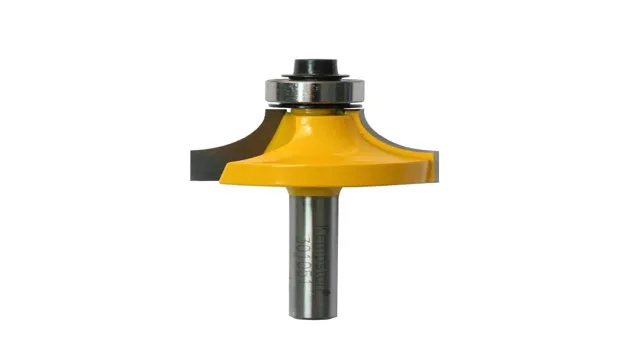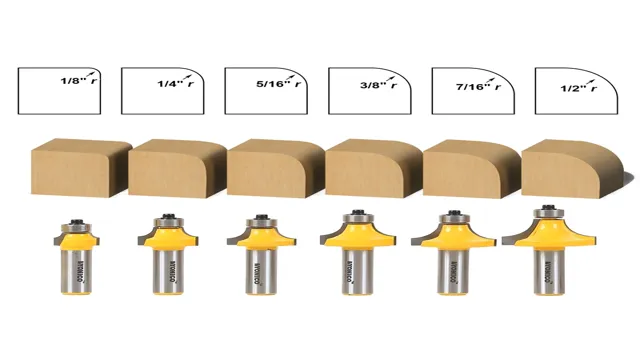When it comes to woodworking, the right tools can make all the difference. And one of the most important tools for shaping and smoothing wood is a router. But with so many different router bits to choose from, it can be overwhelming to know which one is the best fit for your project.
In particular, choosing the right round over bit for 1 inch wood can be tricky. But fear not – we’re here to break it down for you and help you make the best decision for your woodworking needs. First of all, let’s talk about what a round over bit is.
This type of router bit has a curved cutting edge that rounds the edge of the wood. It’s perfect for creating smooth, curved edges and decorative finishes on your woodworking projects. When it comes to 1 inch wood, you’ll want to use a larger diameter round over bit to ensure that you can achieve the desired curve without sacrificing the strength of the wood.
But how do you choose the right size and design of round over bit? This depends on a few factors, such as the thickness of the wood, the size of the project, and the desired curvature of the edge. For 1 inch wood, it’s generally recommended to use a round over bit with a radius between 1/4 and 1/2 inch. This will give you a smooth curve without removing too much material from the wood.
Another thing to consider is the design of the round over bit. Some bits have a more gradual curve, while others have a sharper curve that creates a more pronounced edge. The choice depends on your personal preference and the desired look of your project.
It’s always a good idea to test out different bits on a scrap piece of wood before committing to a specific design. In conclusion, choosing the right round over bit for 1 inch wood requires careful consideration of the diameter, radius, and design of the bit. By taking these factors into account and testing out different options, you can achieve the perfect curve and finish for your woodworking project.
Understanding Round Over Bits
If you’re wondering what size round over bit to use on 1 inch wood, the answer is typically a 1/4 inch round over bit. This will give you a nice, subtle curve along the edge of your wood without being too overwhelming. However, it’s important to note that the size of your round over bit can vary depending on the effect you’re going for and the size of your project.
If you want a more pronounced curve, you could use a 3/8 inch or even a 1/2 inch round over bit. It’s always a good idea to test out different sizes on scrap pieces of wood before committing to your final project. When choosing a round over bit, you’ll also want to consider the type of wood you’re working with and the speed and power of your router.
Overall, using a round over bit can add a nice touch of detail to your woodworking projects.
What is a Round Over Bit?
A round over bit is a tool used in woodworking to create a smooth, curved edge on a piece of wood. It is often used to soften sharp edges and make surfaces safer to handle. Round over bits come in different sizes, allowing woodworkers to create different degrees of curvature on their projects.
The bit itself is circular in shape and has a bearing that guides it along the wood’s edge, ensuring a consistent cut. It’s a great tool for both experienced and beginner woodworkers. Using a round over bit can add a beautiful finishing touch to your woodwork and give it a professional look.
So, if you’re looking to spruce up your woodworking projects or just add to your tool collection, consider a round over bit.

How Does a Round Over Bit Work?
A round over bit is a type of router bit used to create a smooth, rounded edge on wood or other materials. These bits come in different sizes, depending on how large of a round over you want to create. The bit typically has a bearing at the tip that guides it along the edge of the material being routed.
As the bit spins, it cuts away at the sharp edge, leaving behind a smooth, rounded edge that is both visually appealing and safer to touch. Round over bits are commonly used in cabinetry, furniture making, and other woodworking projects where a smooth, finished edge is desired. With the right bit and a little practice, anyone can create beautiful, professional-looking edges on their woodworking projects.
So why not give it a try and see how a round over bit can take your woodworking skills to the next level?
Determining the Size of Round Over Bit You Need
If you’re working with 1-inch thick wood and want to round off the edges, you’ll need to choose the right size round over bit for the job. The size of the bit you choose will depend on the size of the rounded edge you want to create. For a 1/4-inch radius edge, a 1/2-inch round over bit should do the trick.
However, if you want a larger radius, you’ll need to use a larger bit. For example, if you want a 3/8-inch radius, you’ll need to use a 5/8-inch round over bit. It’s important to keep in mind that the larger the radius, the more material the bit will need to remove, which can take more time and effort.
So choose the size carefully based on the design you want, your skill level and experience, and the tools at your disposal. With the right round over bit, you can easily create professional-looking edges on your project, and add a nice finishing touch to your work.
Factors to Consider in Choosing Size of Bit
When it comes to choosing the size of a round over bit, there are several factors to consider. One of the primary factors is the size of the curves you want to create. If you’re working with small curves, a smaller bit, such as a 1/4 inch, would be better suited.
For larger curves, a larger bit, such as a 1-inch, would be more appropriate. Another factor to consider is the type of wood you’re working with. Softer woods like pine or cedar require a smaller bit to prevent tear-out, while harder woods like oak or maple can handle larger bits.
Additionally, the size of the project should be taken into account. For smaller projects, a smaller bit would be more manageable, while larger projects may require a larger bit to speed up the process. Ultimately, choosing the right size round over bit can make a significant difference in achieving the desired result and the overall success of the project.
Measurement of Wood Thickness
If you’re working with wood projects that require roundover bits, it’s essential to know how to determine the right size of the bit you need based on the wood’s thickness. The thickness of the wood will dictate the size of the roundover bit you require. To measure the thickness of the wood accurately, you can use a digital caliper or a tape measure.
Ensure to take the measurement at the thickest point for precise results. For instance, if the wood you’re working on is 3/4 inch thick, you’ll need a 1/4 inch roundover bit for a smooth and even edge. Using a bit that’s too small or too large can result in uneven edges and an unsatisfactory finish.
Always ensure to measure the wood thickness accurately to choose the right size of roundover bit for a professional look and finish.
Range of Bit Sizes Available
When it comes to choosing a round over bit, the range of bit sizes available can be overwhelming. But determining the size you need is crucial to achieving the desired outcome for your project. The size of the bit you choose will affect the depth and width of the rounded edge, as well as the overall appearance of the finished product.
So, how do you determine the size you need? Consider the size of the workpiece, the radius of the round over you want, and the amount of material you want to remove. Smaller bits are ideal for intricate work, while larger bits are better suited for larger pieces or when you want to remove more material. Remember, the goal is to find the perfect balance between getting the job done efficiently and achieving the desired outcome.
By considering these factors and matching them with the appropriate bit size, you can ensure professional-looking results every time.
Conclusion
As with most things in life, the size of your round over bit for 1 inch wood ultimately depends on what you’re trying to accomplish. Are you looking for a subtle edge to soften sharp corners, or a more dramatic rounded shape for a decorative effect? Consider the size and shape of your project, as well as personal preference, before selecting the perfect round over bit. Whether big or small, the right bit can make all the difference in achieving a polished and professional finish.
“
FAQs
What is a round over bit?
A round over bit is a type of router bit that is used to create a curved, rounded edge on a piece of wood.
What size round over bit should I use for 1 inch wood?
It is recommended to use a 1/4 inch round over bit for 1 inch wood.
Can a round over bit be used on other materials besides wood?
Yes, round over bits can also be used on materials such as plastic and metal.
How do I use a round over bit?
To use a round over bit, attach it to a router and adjust the depth to match the desired curve. Then, run the router over the edge of the wood to create the round over.
Is a round over bit the only way to create a curved edge?
No, there are other options such as using a hand plane or sandpaper to round over the edge of the wood.
Can a round over bit be used on an edge that has already been cut or shaped?
Yes, a round over bit can be used on an edge that has been previously cut or shaped.
Are there different types of round over bits available?
Yes, there are various types of round over bits available with different radii and shapes, allowing for more customization in the design of the curved edge.






